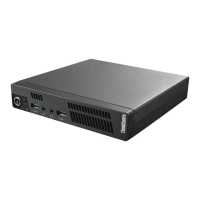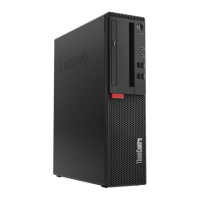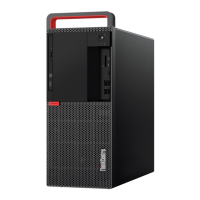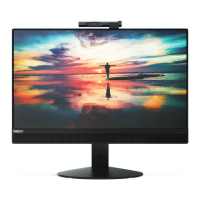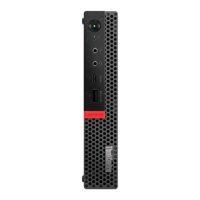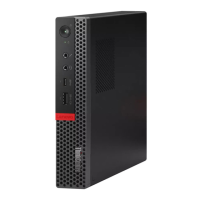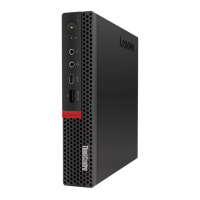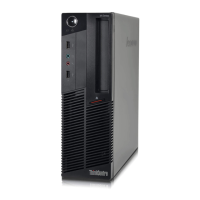











Do you have a question about the Lenovo ThinkCentre M92z and is the answer not in the manual?
Guidelines for servicing your computer and information on Customer Replaceable Units (CRUs).
Precautions to avoid static electricity damage when handling computer components.
Safe usage of power cords, adapters, and maintaining optimal operating environment.
Instructions for cleaning the computer and workspace to ensure proper function.
Details on microprocessor, memory, internal drives, display, and audio subsystems.
Information on Ethernet, system management features, and input/output ports.
Overview of system management features and security functions available on the computer.
Physical specifications of the computer and details on preinstalled Lenovo programs.
Frequently asked questions and accessing system settings via Control Panel.
Instructions for using the keyboard, mouse, and adjusting audio settings.
Guidelines for using CDs/DVDs and information on touchscreen features.
Guidance on accessibility, arranging your workspace for comfort and efficiency.
Advice on lighting, air circulation, and electrical outlet placement.
Procedures for registering your computer and considerations for moving it internationally.
Description of available security features like Computrace, cover presence switch, and TPM.
Setting up BIOS and Windows passwords to protect unauthorized access.
Configuring fingerprint readers, understanding firewalls, and protecting against viruses.
Precautions for safely handling electronic components to prevent static damage.
Instructions for connecting and installing external devices like printers or scanners.
Procedures for replacing components like frame stands, covers, memory, and drives.
Steps to finalize hardware installation or replacement and reconnect cables.
Information on recovery solutions for the Windows 7 operating system.
Information on recovery solutions for the Windows 8 operating system.
Using Rescue and Recovery to back up and restore system data.
Troubleshooting common issues encountered during recovery processes.
How to access and navigate the BIOS Setup Utility program.
Setting system passwords, enabling/disabling devices, and managing startup sequences.
Configuring startup device sequences and enabling power management features.
Information about POST, BIOS, and Setup Utility programs.
Procedures for updating the BIOS from a disc or the operating system.
Steps to recover the computer from a failed POST or BIOS update.
How to get the latest device drivers, operating system updates, and software.
Guidelines for cleaning computer components and good maintenance practices.
Precautions to take before moving your computer to prevent data loss or damage.
Table of common symptoms and verification steps for basic computer issues.
A systematic approach to diagnosing and resolving computer problems.
Troubleshooting for specific issues like audio, CD/DVD, keyboard, monitor, and network.
Using the diagnostic program for troubleshooting and problem resolution.
Accessing useful resources like ThinkVantage Tools, Welcome, and Help & Support.
Information on contacting customer support, warranty, and service options.
Utilizing the Lenovo website for product information, downloads, and services.
List of trademarks for Lenovo, Microsoft, Intel, and other companies.
Information on export classification, electronic emissions, and FCC compliance.
Declarations of conformity with Federal Communications Commission and Industry Canada rules.
Explanation of Waste Electrical and Electronic Equipment (WEEE) marking and regulations.
Lenovo's programs and services for responsible recycling of IT equipment.
Statements regarding RoHS compliance for China, Turkey, Ukraine, and India.
Information on ENERGY STAR compliance and power management features.
Guidelines for servicing your computer and information on Customer Replaceable Units (CRUs).
Precautions to avoid static electricity damage when handling computer components.
Safe usage of power cords, adapters, and maintaining optimal operating environment.
Instructions for cleaning the computer and workspace to ensure proper function.
Details on microprocessor, memory, internal drives, display, and audio subsystems.
Information on Ethernet, system management features, and input/output ports.
Overview of system management features and security functions available on the computer.
Physical specifications of the computer and details on preinstalled Lenovo programs.
Frequently asked questions and accessing system settings via Control Panel.
Instructions for using the keyboard, mouse, and adjusting audio settings.
Guidelines for using CDs/DVDs and information on touchscreen features.
Guidance on accessibility, arranging your workspace for comfort and efficiency.
Advice on lighting, air circulation, and electrical outlet placement.
Procedures for registering your computer and considerations for moving it internationally.
Description of available security features like Computrace, cover presence switch, and TPM.
Setting up BIOS and Windows passwords to protect unauthorized access.
Configuring fingerprint readers, understanding firewalls, and protecting against viruses.
Precautions for safely handling electronic components to prevent static damage.
Instructions for connecting and installing external devices like printers or scanners.
Procedures for replacing components like frame stands, covers, memory, and drives.
Steps to finalize hardware installation or replacement and reconnect cables.
Information on recovery solutions for the Windows 7 operating system.
Information on recovery solutions for the Windows 8 operating system.
Using Rescue and Recovery to back up and restore system data.
Troubleshooting common issues encountered during recovery processes.
How to access and navigate the BIOS Setup Utility program.
Setting system passwords, enabling/disabling devices, and managing startup sequences.
Configuring startup device sequences and enabling power management features.
Information about POST, BIOS, and Setup Utility programs.
Procedures for updating the BIOS from a disc or the operating system.
Steps to recover the computer from a failed POST or BIOS update.
How to get the latest device drivers, operating system updates, and software.
Guidelines for cleaning computer components and good maintenance practices.
Precautions to take before moving your computer to prevent data loss or damage.
Table of common symptoms and verification steps for basic computer issues.
A systematic approach to diagnosing and resolving computer problems.
Troubleshooting for specific issues like audio, CD/DVD, keyboard, monitor, and network.
Using the diagnostic program for troubleshooting and problem resolution.
Accessing useful resources like ThinkVantage Tools, Welcome, and Help & Support.
Information on contacting customer support, warranty, and service options.
Utilizing the Lenovo website for product information, downloads, and services.
List of trademarks for Lenovo, Microsoft, Intel, and other companies.
Information on export classification, electronic emissions, and FCC compliance.
Declarations of conformity with Federal Communications Commission and Industry Canada rules.
Explanation of Waste Electrical and Electronic Equipment (WEEE) marking and regulations.
Lenovo's programs and services for responsible recycling of IT equipment.
Statements regarding RoHS compliance for China, Turkey, Ukraine, and India.
Information on ENERGY STAR compliance and power management features.
| Tcase | 69.1 °C |
|---|---|
| Bus type | DMI |
| Processor cache | 6 MB |
| Processor cores | 4 |
| Processor model | i5-3470S |
| System bus rate | 5 GT/s |
| Processor family | Intel® Core™ i5 |
| Processor series | Intel Core i5-3400 Desktop series |
| Processor socket | LGA 1155 (Socket H2) |
| Processor codename | Ivy Bridge |
| Processor frequency | 2.9 GHz |
| Processor cache type | Smart Cache |
| Processor lithography | 22 nm |
| Processor manufacturer | Intel |
| Conflict-Free processor | Yes |
| Processor front side bus | - MHz |
| PCI Express slots version | 3.0 |
| Processor boost frequency | 3.6 GHz |
| Processor operating modes | 64-bit |
| ECC supported by processor | No |
| PCI Express configurations | 1x16, 2x8 |
| Thermal Design Power (TDP) | 65 W |
| CPU multiplier (bus/core ratio) | 29 |
| Memory types supported by processor | DDR3-SDRAM |
| Memory channels supported by processor | Dual |
| Memory clock speeds supported by processor | 1333, 1600 MHz |
| Memory bandwidth supported by processor (max) | 25.6 GB/s |
| Maximum internal memory supported by processor | 32 GB |
| Motherboard chipset | Intel® Q77 Express |
| Memory slots | 2 |
| Internal memory | 4 GB |
| Memory slots type | SO-DIMM |
| Memory clock speed | 1600 MHz |
| Maximum internal memory | 16 GB |
| Memory layout (slots x size) | 1 x 4 GB |
| HDD speed | 7200 RPM |
| HDD interface | SATA |
| Storage media | HDD |
| Optical drive type | DVD±RW |
| Total storage capacity | 500 GB |
| Compatible memory cards | - |
| Number of storage drives installed | 1 |
| Storage drive interface | Serial ATA |
| Display diagonal | 23 \ |
| Touch technology | Multi-touch |
| Native aspect ratio | 16:9 |
| On-board graphics card ID | 0x152 |
| On-board graphics card model | Intel® HD Graphics 2500 |
| On-board graphics card family | Intel® HD Graphics |
| On-board graphics card base frequency | 650 MHz |
| On-board graphics card dynamic frequency (max) | 1150 MHz |
| Number of displays supported (on-board graphics) | 3 |
| Total megapixels | 2 MP |
| Audio system | HD |
| Wi-Fi standards | 802.11b, 802.11g, Wi-Fi 4 (802.11n) |
| Ethernet LAN data rates | 10, 100, 1000 Mbit/s |
| USB 2.0 ports quantity | USB 2.0 ports have a data transmission speed of 480 Mbps, and are backwards compatible with USB 1.1 ports. You can connect all kinds of peripheral devices to them. |
| Product color | Black |
| Operating system installed | Windows 7 Professional |
| Sustainability certificates | RoHS, EPEAT Gold, ENERGY STAR |
| Processor ARK ID | 68315 |
| Intel TSX-NI version | 0.00 |
| Processor package size | 37.5 mm |
| Supported instruction sets | AVX, SSE4.1, SSE4.2 |
| Thermal solution specification | PCG 2011C |
| Intel Identity Protection Technology version | 1.00 |
| Depth (with stand) | 100 mm |
|---|---|
| Width (with stand) | 568 mm |
| Height (with stand) | 447 mm |
| Weight (with stand) | 10900 g |
